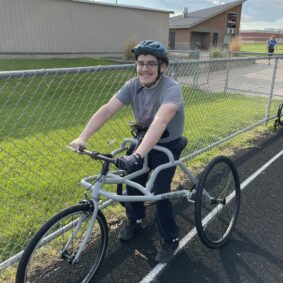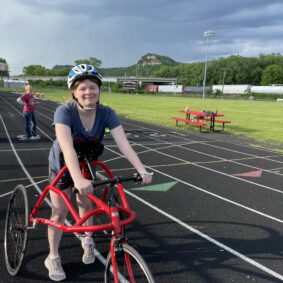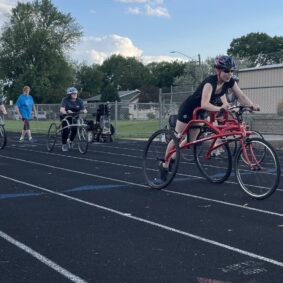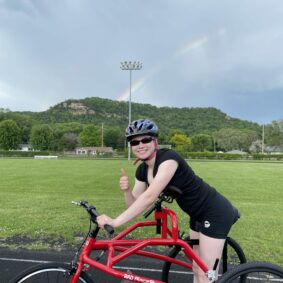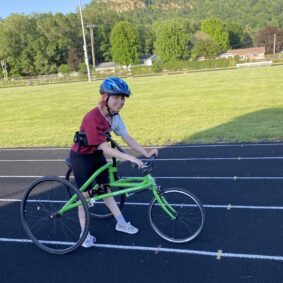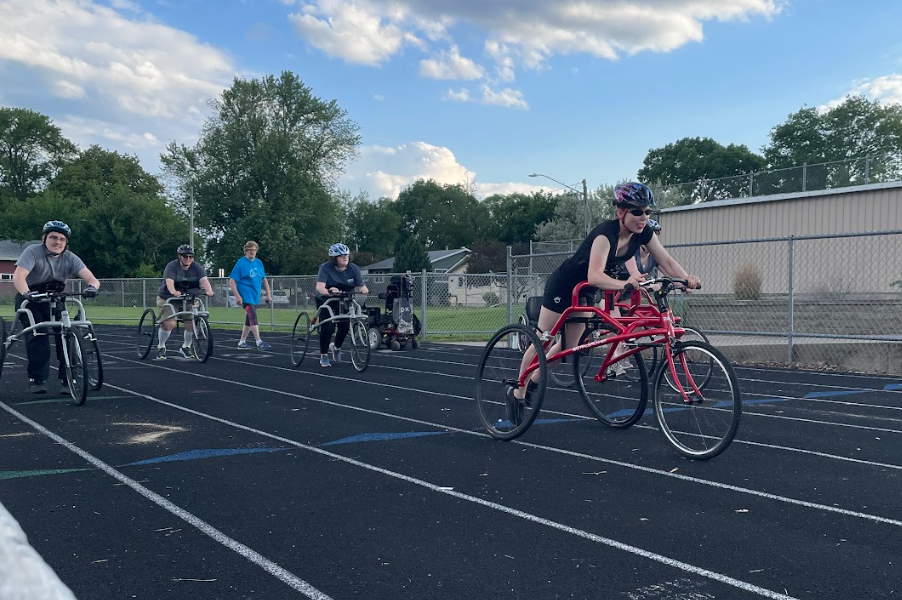
Adaptive & Para Track and Field
Para and adaptive track and field is more than just race wheelchairs—ambulatory, race runner frames, prosthetics, or visually impaired—there’s a way almost everyone can be accommodated to participate.
Who can participate in Adaptive/Para Track and Field?
Anyone, youth and adult, who has a mobility or cognitive challenge that makes participation in traditional programming difficult. This program is co-ed.
- Spina bifida
- Spinal cord injury
- Cerebral palsy
- Congenital limb issues
- Amputations
- Leg length discrepancy
- Short stature
- Muscular dystrophy
- Parkinson’s disease
- Multiple sclerosis
- Motor dyspraxia
- Limited range of motion
- Balance issues
- Post stroke
- Blind and visual impairment
- Down syndrome
- Autism spectrum
- Learning disabilities
- Cognitive impairments
- Low muscle tone
- Other congenital syndromes
Individuals may ambulate independently, or use assistive devices, or wheelchairs.
Come and try Adaptive and Para Track and Field. We offer a one day free trial. Care partners are welcome to participate in sessions for no additional cost and all equipment is included. Visit our online calendar for current session information.
When is this program offered?
This program is offered in during the evening throughout the summer!
Check out our Calendar to stay up to date when it is occurring.
Interested in competing?
Iowa, Wisconsin, and Minnesota students are able to represent their school on the track and field team. With the skills you learn, you may also enjoy community runs/walks, 5Ks, half marathons, or marathons. You may also compete in throwing events.
How can I participate?
Race wheelchairs are used by athletes who do not have strength or control of their legs to support themselves in a standing position. The race wheelchair is very lightweight. You will either be seated or in a tucked position. The athlete wears special gloves with a rubber surface which are used to push against the push rim. The race wheelchair ‘steers itself’ through a mechanism called a compensator. Events for the race wheelchair include sprints, middle distance, 1K, 2K, 5K, half marathon, and marathon.
Individuals with prosthetics are able to participate with conventional prothesis, or special sport blade prothesis. Some individuals with limb deficiencies and amputations compete seated.
Blind and visually impaired individuals are able to participate in most track running events and road races with the assistance of a guide. The guide uses verbal cues to let the athlete know where they are on the track and relationship with obstacles and other athletes.
What are paralympic classifications?
There are six broad Paralympics categories: amputee, cerebral palsy, intellectual disability, wheelchair, vision impairment, and “others.” All of these categories can be involved in adaptive track and field and other para sports. Paralympic classifications are how the Paralympics identify athletes with similar challenges and group them into a competitive “class.” Classification looks at an individual’s function of their arms, legs, trunk, cognition, and eyes- not just diagnosis. Muscle tone, spasticity, and coordination are also utilized to determine your classification.
Introducing race running frames
Race running has more than a 30-year history in Europe. Developed by the Cerebral Palsy International Recreation Association (CPISRA), it is now a demonstration sport in the Paralympics. Race running is done with a three wheeled frame that has no pedals. A seat and chest plate support the athlete as they propel the frame with their legs. The STAR Center is excited to offer this piece of adaptive equipment. We are one of the first organizations in the country to offer programming in this sport. See a race runner in action!
Who can use a race running frame?
Individuals with a limited range of motion, alterations of muscle tone, weakness, or balance issues can use race runners. Individuals who normally use power chairs can successfully participate.
- Cerebral palsy
- Muscular dystrophy
- Spasticity
- Arthritis
- Parkinson’s disease
- MS
- Spina bifida
- Balance issues
- Ataxia
- Motor dyspraxia
Adaptive throwing and jumping
Adaptive throwing includes shot put, discus, javelin, and club. The weights of the instrument vary by age and sex. Throwing events are done either seated or standing, depending on the participant’s disability.
Seated throwers use a throwing chair. Straps can be customized to help secure the athlete, and some participants may utilize a back support or footrest. A post located on the chair is held by the non-throwing hand.
Standing athletes may utilize a support frame to help with stability. All six primary categories of Para Athletes can compete in the throwing events.
Shot put can be done seated or standing. The shot starts just under the jaw near your ear, the arm is then extended upward at a 45 degree angle. The shot is pushed, not thrown.
The discus was in the ancient Olympics. Like other throwing events, it can be done seated or standing, depending on the classification. The disc is saucer shaped and weighs between .75kg to 2kg, depending on age and sex. It is thrown with a ‘side arm’ technique.
The javelin is a long spear like instrument. It can be done seated or standing. The weight and length of the javelin varies with the age of the athlete. Younger athletes use practice javelins with a rubber tip, while older competitors use a metal tipped javelin. The javelin is thrown in an “overhand” position.
Adaptive jumping includes long jump, high jump and triple jump.

